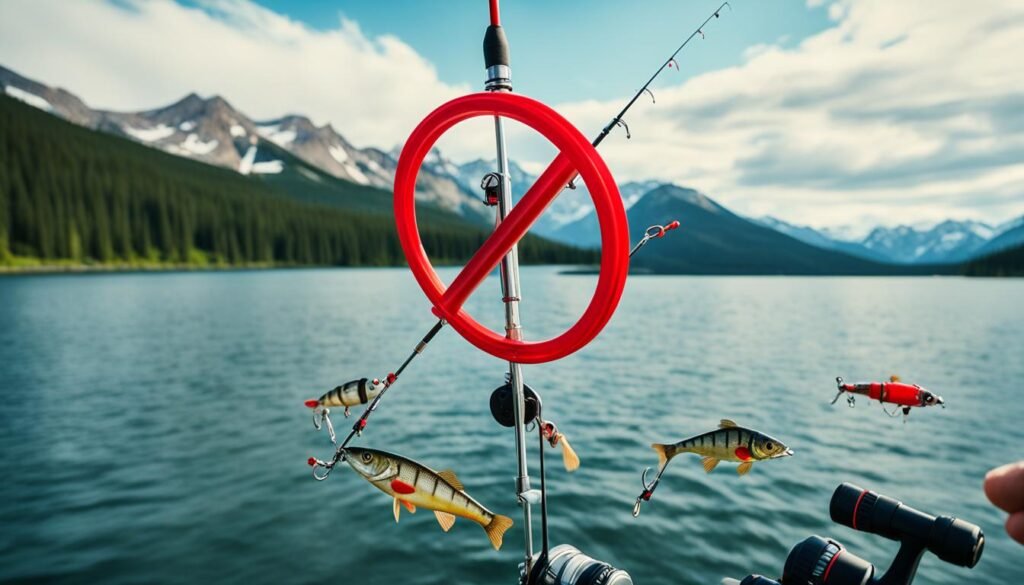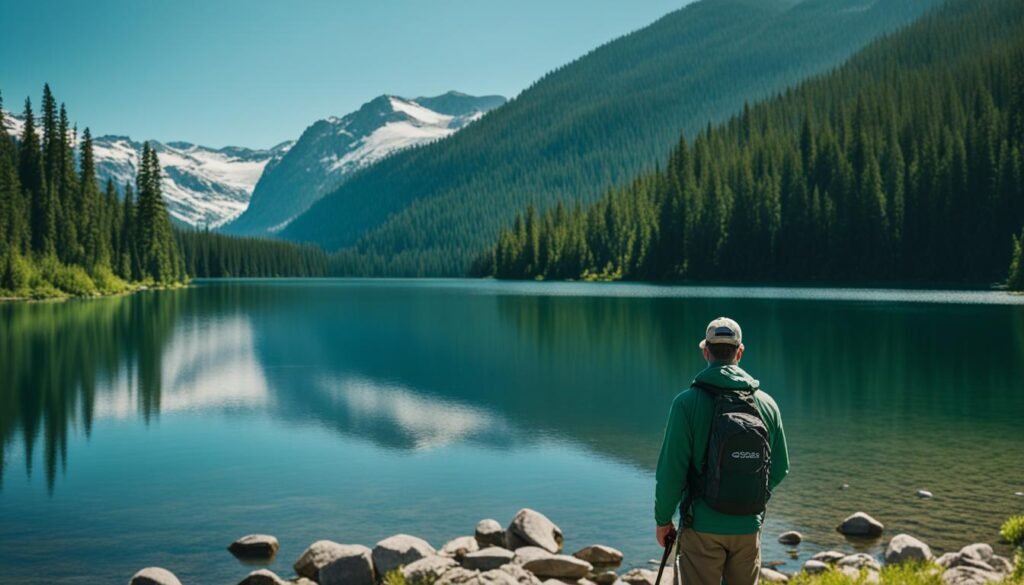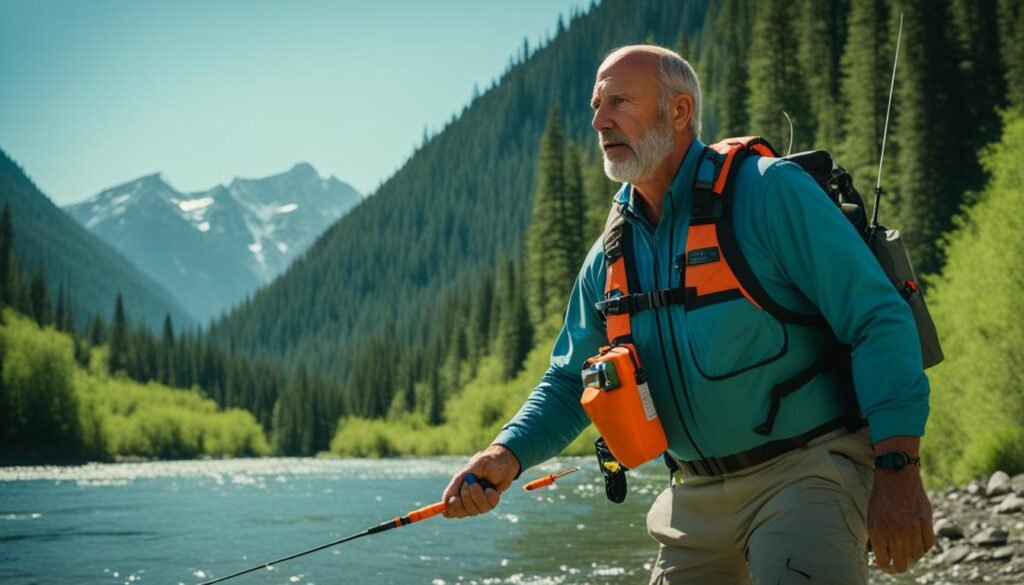Planning to fish in Canada’s national parks?
It’s vital to know the fishing rules first. These regulations protect nature and enhance your experience.
Understanding permits, gear restrictions, and ethical practices is key. This knowledge ensures both ecosystem health and your enjoyment of fishing.
Key Takeaways about National Parks Fishing Regulations
- Obtaining a valid national park fishing permit is mandatory before casting your line
- Using natural bait, certain lures, and lead tackle is prohibited to protect fragile aquatic habitats
- Anglers must adhere to catch and possession limits to support sustainable fishing practices
- Proper fish handling techniques and the prevention of aquatic invasive species are critical
- Awareness of closed waters and seasonal regulations is key to a successful and responsible fishing experience
Importance of Fishing Permits in National Parks
Anglers in Canada’s national parks need a valid national park fishing permit. These permits differ from provincial licenses. They’re crucial for legal fishing and support conservation efforts in these delicate ecosystems.
Permit Requirements and Validity
A valid national park fishing permit must be with anglers while fishing. You can buy these permits online, at park centers, or from authorized sellers.
The permit’s validity matches your national park pass. This ensures you follow all access rules.
Exceptions for Children and Accompanying Adults
- Children under 16 can fish without a permit. They must be with a national park fishing permit holder aged 16 or older.
- The child’s catch counts towards the adult’s daily limit.
Anglers should know the fishing regulations for each national park they visit. Rules may differ between protected areas.
Following these rules helps maintain healthy aquatic ecosystems. It also ensures a fun, sustainable fishing experience for everyone.
“Fishing in national parks is conducted in accordance with the NPS general fishing regulations as per 36 CFR §2.3.”
Prohibited Fishing Gear and Bait

Canada’s national parks have strict rules for fishing gear and bait. These rules protect ecosystems and fish populations. Prohibited fishing gear and banned bait are not allowed in parks.
Natural Bait and Chemical Attractants Ban
Fishing with natural bait or chemical attractants is illegal within 100 metres of park waters. This includes baitfish, worms, insects, and other organic materials.
Anglers can only use artificial lures made of feathers, fibre, rubber, wood, metal or plastic. These lures can’t have edible parts or scented additives.
Restrictions on Lead Tackle and Lures
Lead tackle under 50 grams is not allowed in national parks. This includes sinkers, jigs, and lures. Anglers must use non-toxic options like steel, tin, or copper instead.
Lures with more than two gang hooks are also banned. These can harm or kill fish by accident.
- Anglers are restricted from using lead tackle under 50 grams within national park waters.
- Lures with more than two gang hooks are banned to prevent unintended harm to fish.
- Only artificial lures made of feathers, fibre, rubber, wood, metal or plastic are permitted, without any edible or scented materials.
“Protecting the delicate ecosystems and fish populations in our national parks is paramount. That’s why we have strict regulations in place to prohibit the use of certain fishing gear and bait.”
Following these national park fishing rules helps protect our natural resources. It also ensures an enjoyable and ethical fishing experience.
Ethical Angling Practices

Fishing in Canada’s national parks requires ethical angling practices. These practices ensure sustainable aquatic ecosystems and responsible outdoor experiences. They also help preserve our natural resources for the future.
Catch and Possession Limits
National park anglers must follow catch and possession limits for fish species. It’s illegal to possess more than 2 game fish at once. Fishing must stop after reaching the daily limit.
These rules help maintain healthy fish populations. They also prevent waste and protect our aquatic resources.
Preventing Fish Harassment and Waste
Anglers should never harass fish by throwing objects or blocking their movements. It’s important to handle caught fish properly to avoid spoilage.
Quick release or proper storage and consumption are key. These practices minimize the impact on the natural environment.
| Ethical Angling Practice | Impact on Fish and Aquatic Ecosystems |
|---|---|
| Adhering to catch and possession limits | Maintains healthy fish populations and prevents overfishing |
| Avoiding fish harassment | Minimizes stress and disturbance to fish, allowing them to thrive |
| Properly handling and releasing caught fish | Increases the survival rate of released fish, supporting population recovery |
| Properly disposing of fishing waste and line | Prevents harm to aquatic life and the environment |
Ethical angling helps preserve Canada’s national parks. It ensures future generations can enjoy unique fishing opportunities in these protected areas.
“Responsible anglers play a crucial role in maintaining the health and balance of our aquatic ecosystems. By adhering to ethical practices, we can ensure that our national parks continue to thrive for years to come.”
National Parks Fishing Regulations
Fishing in Canada’s national parks requires knowledge of Parks Canada’s rules. These cover allowed methods, catch limits, and other guidelines. They ensure responsible fishing in protected natural areas.
A national park fishing permit is needed to fish in these parks. Provincial licenses don’t apply here. Kids under 16 can fish without a permit if with a permit holder.
Anglers must carry their permit while fishing. Natural bait and chemical attractants are banned within 100 meters of park waters. Only lures under 50 grams are allowed in this area.
Fishing with a line that can catch more than one fish at once is not allowed. Anglers should follow these rules to avoid breaking regulations.
| Possession Limits | Daily Catch Limit |
|---|---|
| Pike (only 1 may exceed 76 cm): 3 | Pike (only 1 may exceed 76 cm): 3 |
| Walleye: 2 | Walleye: 2 |
| Perch: 5 | Perch: 5 |
| Whitefish: 5 | Whitefish: 5 |
| Lake trout: 1 | Lake trout: 1 |
| Combined: 5 | Combined: 5 |
Parks Canada aims to prevent the spread of aquatic invasive species. Anglers should clean, drain, and dry their equipment. This helps stop species like Whirling Disease and invasive mussels.
Understanding national parks fishing regulations is crucial. It helps anglers fish responsibly while enjoying Canada’s beautiful protected areas.
Preventing the Spread of Aquatic Invasive Species
Preserving Canada’s national park ecosystems is vital. Anglers help prevent aquatic invasive species (AIS) from harming freshwater habitats. They must follow the clean, drain, dry protocol when moving between water bodies.
Clean, Drain, and Dry Protocol
Anglers must clean their gear to remove plants, animals, and mud. They should drain any leftover water from their equipment. Lastly, they must dry everything before entering another body of water.
Most mountain parks require an AIS Prevention permit. This is needed to access waterbodies with any watercraft, gear, or angling equipment.
Reporting Sightings of Invasive Species
Stay alert for aquatic invasive species like whirling disease, invasive mussels, or Eurasian water milfoil. Report any sightings to help Parks Canada monitor these threats. Email ReportAIS-SignalerEAE@pc.gc.ca with details, photos, and location info.
Anglers protect Canada’s parks by following these rules. They help prevent the spread of AIS and preserve our freshwater ecosystems. These actions safeguard our waters for future generations to enjoy.
Safety Considerations for Anglers

Fishing in Canada’s national parks requires careful safety measures. Wearing a personal flotation device (PFD) is crucial when on the water. Every watercraft must have a lifejacket or PFD for each person on board.
Mountain lakes are often cold, risking hypothermia if a boat capsizes. Anglers should always wear a PFD to stay safe. Weather conditions can change quickly, creating large waves in minutes.
Plan to paddle closer to shore if bad weather approaches. This ensures a quick and safe return to land.
Wearing Personal Flotation Devices (PFDs)
Anglers must wear a PFD at all times while on the water. Penalties for angling infractions can be severe. Fines can reach $100,000, with possible imprisonment up to 12 months.
Serious offenses may result in automatic license suspensions. These can last from one to five years, along with increased fines.
Awareness of Cold Water and Weather Conditions
Anglers must be aware of cold water and changing weather risks. It’s illegal to fish in closed waters or during closed seasons. Monitor weather forecasts closely and be ready to return to shore quickly.
“It’s crucial for anglers to prioritize their safety while enjoying the natural beauty of Canada’s national parks. Wearing a PFD and staying alert to changing weather conditions can help ensure a successful and enjoyable fishing experience.”
Follow these safety tips to protect yourself while fishing in national parks. Stay informed and prepared for a responsible and fun angling experience. Your safety is key in these protected natural environments.
Open Seasons and Closed Waters
Fishing in Canadian national parks requires knowledge of specific regulations. These rules determine when and where you can fish in rivers, streams, and lakes. Understanding open and closed waters is vital for a successful fishing trip.
Banff National Park allows fishing at different times throughout the year. Jasper National Park has various fishing periods for its rivers and lakes. Waterton Lakes National Park offers fishing in select waters during specific seasons.
Kootenay National Park’s fishing season runs from June 15 to October 31. Yoho National Park permits fishing in certain waters at different times. Each park has its own unique fishing schedule.
- Wood Buffalo National Park allows fishing in all waters from Victoria Day to October 15.
- Prince Albert National Park has designated fishing seasons from Victoria Day to Labour Day, Victoria Day to September 30, and May 15 to September 30 based on water bodies.
- Georgian Bay Islands National Park permits fishing from July 1 to September 30 in all waters.
- Terra Nova National Park allows trout fishing in Dunphy’s Pond from Victoria Day to the third Sunday of August and ice fishing for trout from the Third Saturday of February to the fourth Sunday of March.
National park fishing seasons and open and closed waters differ across Canadian parks. Anglers must check the rules for each park they visit. This ensures they fish legally and responsibly.
Knowing national park fishing regulations helps anglers enjoy Canada’s natural beauty. It also protects the delicate ecosystems and valuable resources within these parks. Responsible fishing preserves these areas for future generations.
Definitions and Terminology
Fishing in Canada’s national parks requires knowledge of key terms. Let’s explore important fishing-related definitions used in the regulations.
Angling, Artificial Fly, and Tributary Definitions
Angling means fishing with a hook and line or rod held in the hand. It doesn’t include using a set line.
An artificial fly is a single or double hook on a common shank. It’s dressed with various materials, excluding lead, without a spinning device.
A tributary is a watercourse flowing into another body of water. This includes tributaries to tributaries, but not lakes unless specified.
The regulations also cover other fishing terms. These include organic bait, artificial lures, and barbless hooks.
- Organic bait: Any plant or animal part used for fishing, such as worms, minnows, frogs, crayfish, crickets, etc.
- Artificial lures: Includes spoons, plugs, jigs, and artificial flies like wet flies, dry flies, and streamer flies dressed with various materials.
- Barbless hook: A hook with the barb completely removed or flattened against the shaft.
Understanding these terms helps you follow the rules in Canada’s national parks. It’s crucial for responsible fishing and compliance.
“Staying informed about the definitions and terminology used in national parks fishing regulations is essential for anglers to ensure they are fishing responsibly and in compliance with the rules.”
Conclusion
Canadian national parks fishing rules promote responsible angling. They protect aquatic ecosystems and biodiversity. Anglers must follow permit requirements, gear restrictions, and catch limits to conserve these natural spaces.
Responsible angling goes beyond following rules. It means minimizing environmental impact and respecting ecosystem balance. Anglers should prevent invasive species spread and handle fish carefully.
These regulations safeguard delicate natural habitats. They ensure unique destinations remain thriving. By following them, anglers help preserve Canada’s national parks for future generations.
Protecting aquatic ecosystems is crucial. It keeps natural wonders accessible and healthy. Anglers play a vital role in maintaining these spaces for everyone’s enjoyment.
For an overview of fishing regulations and licenses in Canada, please check this guide
FAQ about National Parks Fishing Regulations
What are the key rules and regulations for fishing in Canada’s national parks?
Fishing in national parks requires a valid permit. Natural bait, chemical attractants, and lead tackle under 50 grams are banned. Anglers must follow catch limits and avoid harassing fish.
Proper fish disposal is crucial. Lures with more than 2 gang hooks and lines catching multiple fish are prohibited.
Do provincial fishing licenses work in national parks?
No, provincial licenses aren’t valid in national parks. A separate national park fishing permit is required for legal fishing in these areas.
Are there any exceptions to the national park fishing permit requirement?
Kids under 16 can fish without a permit if with an adult who has one. Their catch counts towards the adult’s daily limit.
What types of fishing gear and bait are prohibited in national parks?
Natural bait, chemical attractants, and lead tackle under 50 grams are banned. Lures with more than 2 gang hooks are not allowed.
Only artificial lures made of feathers, fiber, rubber, wood, metal or plastic are permitted. Lines catching multiple fish at once are prohibited.
What are the catch and possession limits for fishing in national parks?
Anglers can possess a maximum of 2 game fish at any time. Fishing must stop after reaching the daily catch limit.
Allowing caught fish to spoil or be wasted is illegal.
How can anglers help prevent the spread of aquatic invasive species in national parks?
Clean, drain, and dry all equipment before moving between water bodies. This stops the spread of invasive species like whirling disease.
Report any sightings of suspected invasive species to park authorities. This helps protect the park’s ecosystem.
What safety precautions should anglers take in national parks?
All watercraft must have a personal flotation device (PFD) for everyone on board. Wearing PFDs is strongly encouraged to prevent hypothermia.
Be aware of changing weather conditions that can create dangerous waves. Mountain lakes can be very cold and risky.
When and where can I fish in national parks?
The National Parks of Canada Fishing Regulations outline open seasons and permitted fishing locations. Anglers must follow seasonal closures and restrictions on rivers, streams, and lakes.
What is the definition of “angling” in the national parks regulations?
Angling means fishing with a hook and line or rod held in hand. It doesn’t include set lines.
An “artificial fly” is a single or double hook with materials like silk or feathers, without a spinning device.
Source Links
- https://www.destinationontario.com/en-ca/articles/fishing-ontarios-provincial-and-national-parks
- https://www.algonquinpark.on.ca/visit/recreational_activites/fishing-in-algonquin-park.php
- https://www.nps.gov/subjects/fishing/how-regulations-work.htm
- https://parks.canada.ca/pn-np/bc/glacier/activ/peche-fishing
- https://parks.canada.ca/pn-np/bc/glacier/activ/experiences/-/media/B0A2885F0A304740A48CE750C58F9F6D.ashx?modified=20170510174302
- https://albertaregulations.ca/fishingregs/general-regs.html
- https://laws-lois.justice.gc.ca/eng/regulations/C.R.C.,_c._1120/page-1.html
- http://www.ontario.ca/document/ontario-fishing-regulations-summary/general-fishing-regulations
- https://www.nps.gov/subjects/fishing/responsible-fishing.htm
- https://www.saumonquebec.com/en/fishing/the-basics/ethics-for-anglers
- https://anglerscovey.com/2012/12/07/catch-and-release-a-brief-history-and-ethical-practices/
- https://parks.canada.ca/pn-np/ab/jasper/activ/experience/ete-summer/peche-fishing
- https://laws-lois.justice.gc.ca/eng/regulations/C.R.C.,_c._1120/FullText.html
- https://parks.canada.ca/pn-np/mtn/eaux-waters
- https://laws-lois.justice.gc.ca/eng/regulations/sor-2015-121/FullText.html
- https://www.dfo-mpo.gc.ca/species-especes/ais-eae/control-management-controle-gestion/index-eng.html
- https://www.saskatchewan.ca/residents/parks-culture-heritage-and-sport/hunting-trapping-and-angling/angling/regulations
- https://bcparks.ca/plan-your-trip/visit-responsibly/fishing-hunting-guide/
- https://laws-lois.justice.gc.ca/eng/regulations/C.R.C.,_c._1120/page-5.html
- https://www.pac.dfo-mpo.gc.ca/fm-gp/rec/bc-zones-cb-eng.html
- https://www.nps.gov/glac/planyourvisit/fishing.htm
- https://www.pac.dfo-mpo.gc.ca/fm-gp/rec/restricted-restreint-eng.html
- https://www.ontario.ca/page/rules-using-fishing-tackle
- https://globalnews.ca/news/10372346/invasive-species-restrictions-canada-parks/
- https://parks.canada.ca/pn-np/ab/waterton/activ/experiences/peche-fishing/reglement-regulations


